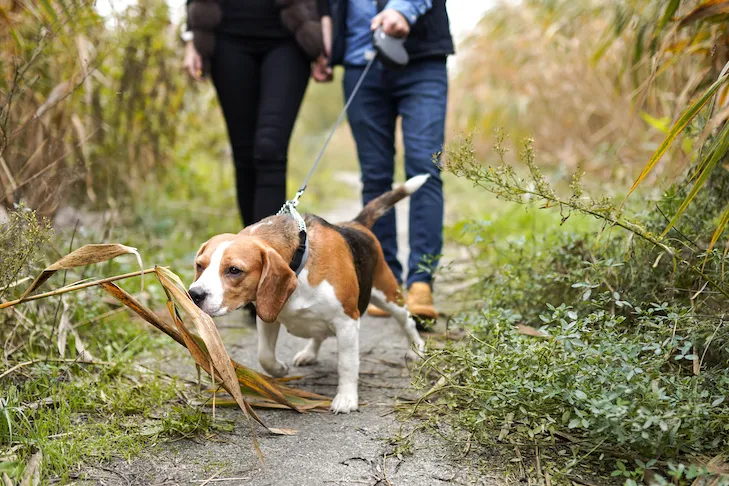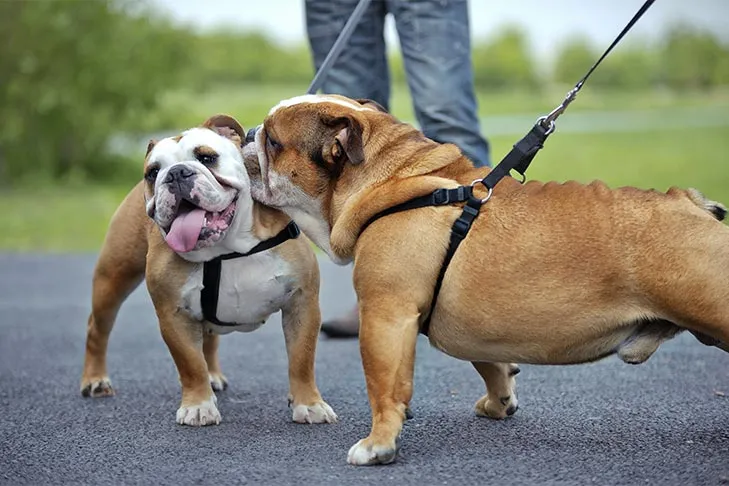Walking two small dogs simultaneously can often turn a pleasant outing into a tangled mess. Leashes intertwine, you juggle multiple handles, and it can feel like your little companions are pulling you in opposite directions. For many small dog owners, a Double Dog Leash For Small Dogs offers an elegant solution, simplifying multi-dog walks into a more manageable and enjoyable experience.
While consistent training in loose-leash walking remains paramount for any dog, under the right conditions, a specialized double dog leash can significantly enhance your daily routine. This guide will explore everything you need to know about these practical tools and help you determine if they are the right choice for your small canine companions. best website to buy dog supplies
What is a Double Dog Leash, and Why Consider One for Small Dogs?
A double dog leash, often referred to as a coupler, is a specialized accessory designed to allow you to walk two dogs with a single handle. The main leash splits into two shorter sections near the bottom, with each section attaching to a separate dog’s harness or collar. The primary advantage of using a double dog leash for small dogs is the elimination of tangled leashes and the convenience of holding just one handle, freeing up your other hand for treats, bags, or simply navigating.
The market offers a diverse range of double leashes, featuring various options tailored to different dog sizes and walking styles. For small dogs, specific features become particularly important. Many designs incorporate reflective stitching for visibility during evening walks, swiveling connectors to prevent tangles as your dogs move, and bungee cord ends to minimize strain on your arm and provide a gentle buffer for sudden movements. Some advanced models even allow for adjustable lengths on each side, which is incredibly useful if your small dogs are of different heights or have slightly varied walking paces. Crucially, there are lightweight, less bulky versions specifically crafted for the delicate frames and lower pulling power of small dog breeds. When selecting a double dog leash for small dogs, consider models made with durable yet light materials that won’t overwhelm your pets.
 Two Entlebucher Mountain Dogs wearing harnesses and connected by a double leash, looking alert outdoors.
Two Entlebucher Mountain Dogs wearing harnesses and connected by a double leash, looking alert outdoors.
Are Your Small Dogs Good Candidates for a Double Leash?
While a double dog leash can be a game-changer for walking two small dogs, it’s not universally suitable. According to Rachel Lane, a renowned dog trainer, certified behavior consultant, and owner of Leash & Learn, these tools are best reserved for specific circumstances. “Double leashes are most appropriate for dogs who are already well-trained, can walk on a loose leash, do not react aggressively to anything in their environment, and get along with each other without any history of conflict between them,” she advises. This guidance is especially pertinent when considering a double dog leash for small dogs, as their perceived manageability can sometimes lead owners to overlook fundamental training needs.
It’s vital to objectively assess each of your small dogs’ individual walking styles. Every dog possesses a unique personality, and their behavior on walks can vary significantly. For instance, if one of your small dogs zips ahead while the other prefers to amble and sniff every blade of grass, a double leash would likely create frustration for both you and your pets. Lane emphasizes that only dogs who enjoy similar walking activities should be paired with a coupler. Two small dogs who both enjoy leisurely strolls and extensive sniffing, for example, would be a much better match.
Attempting to walk two small dogs with incompatible walking styles on a double leash can lead to a less enjoyable experience for everyone involved. As Lane explains, “dogs have goals for their walks,” and if these goals are in opposition, neither dog’s needs are truly met. Such incompatibility means they “would not benefit from a double leash because their behavior is incompatible with one another in terms of how they like to spend their time on a walk.” This principle applies strongly to small dogs, where a mismatch in energy or focus can quickly lead to pulling, lagging, or general discomfort for both dogs.
When NOT to Use a Double Dog Leash with Small Dogs
Despite their convenience, double leashes are not appropriate for all small dogs, particularly those who haven’t mastered basic leash manners. Until your small dogs consistently demonstrate polite walking behavior, it’s far more effective to walk them individually, using each outing as a dedicated training session. Lane stresses that double leashes should be used with extreme caution with any dog who pulls on the leash, even if they are small in size. The cumulative pulling force of two small dogs can still be surprisingly strong, posing a significant safety risk for the handler. Imagine one small dog darting left while the other pulls right – the sudden, opposing forces can easily throw an owner off balance or cause injuries.
 A young couple walking their small beagle dog, which is sniffing the ground and pulling on its leash, on an outdoor path.
A young couple walking their small beagle dog, which is sniffing the ground and pulling on its leash, on an outdoor path.
Dog walking injuries are not uncommon, and handlers frequently sustain injuries from tripping over their dogs, getting tangled in leashes, or being pulled forcefully. A study published in the Journal of the American Veterinary Medical Association highlighted dog-pulling behavior as a leading cause of such injuries. While the dog’s training level, behavior, and the handler’s skill are more significant factors than the type of leash itself, Lane advises that even greater precautions are necessary for handler safety when two dogs are walked together on a double leash. This is particularly relevant for owners of small dogs who might underestimate the potential for injury. best online shopping for dogs
The dynamic between the two dogs themselves is another critical consideration. It can be challenging to manage two small dogs on a coupler if they constantly try to play or, worse, if one dog incites the other. For example, if one small dog becomes overly excited or stimulated by an external factor, this can easily trigger the other dog to join in the frenzy. Similarly, if one dog exhibits reactive behavior—such as barking, lunging, growling, staring, or snarling—towards other dogs or stimuli in the environment, the risk of redirection becomes a serious concern. The overstimulated dog might redirect its frustration or discomfort onto its companion, leading to conflict. Therefore, avoid using a double dog leash for small dogs if either of them displays any reactive tendencies during walks.
Furthermore, double leashes are entirely inappropriate for small dogs who merely tolerate each other or have a history of conflict. Lane emphasizes the crucial role of space in canine behavior, especially during disagreements. When two dogs are confined to a double leash, “they have no way to move themselves away from the other dog.” This forced proximity can escalate minor tensions into full-blown fights that might otherwise be avoided if the dogs had the option to create distance.
 Two small Bulldogs wearing harnesses and leashes, interacting cautiously with each other outdoors.
Two small Bulldogs wearing harnesses and leashes, interacting cautiously with each other outdoors.
Training Tips for Small Dogs Using a Double Leash
Before you even consider purchasing a double dog leash for small dogs, Lane strongly recommends establishing a solid foundation in loose-leash walking for each dog individually. “They should walk cooperatively in any direction the handler chooses, respond to their owner’s cues the first time they are asked, focus on their handler in any situation or environment, and they should be able to walk on a loose leash at a variety of paces/pace changes,” she explains. This rigorous preparation ensures that both small dogs are well-behaved and attentive, making the transition to a double leash much smoother and safer.
Even if you successfully integrate a double dog leash into your routine with your well-behaved small dogs, it’s crucial not to neglect regular one-on-one walks. These individual outings offer unique benefits that group walks can’t provide. Solo walks allow you to closely monitor each dog for any subtle changes in posture, movement, or behavior, which is essential for early detection of health issues, especially as they age. They also present perfect opportunities to refresh training cues and reinforce good manners without the distractions of a second dog. Most importantly, individual walks provide undivided attention and quality interaction, strengthening the bond between you and each of your beloved small companions. best cooling blanket for dogs
Conclusion
A double dog leash for small dogs can be an excellent tool for streamlining walks and enhancing convenience for owners of multiple small canine companions. However, its effectiveness and safety are entirely dependent on thoughtful consideration of your dogs’ individual temperaments, training levels, and compatibility. Prioritizing loose-leash training for each dog, understanding their unique walking styles, and being mindful of their interactions are crucial steps before opting for a coupler. Remember, while a double leash offers practicality, the bond you share with each of your small dogs, nurtured through individual attention and consistent training, remains the most vital ingredient for happy and harmonious walks. Always consult with a professional dog trainer if you encounter challenges or need personalized advice for your specific situation.
References
- Lane, Rachel. Dog Trainer, Certified Behavior Consultant, and Owner of Leash & Learn. (Expert insights quoted throughout the article).
- Journal of the American Veterinary Medical Association. Dog-Walking Related Injuries to Handlers: A 2024 Study. (Cited for handler injury statistics).
